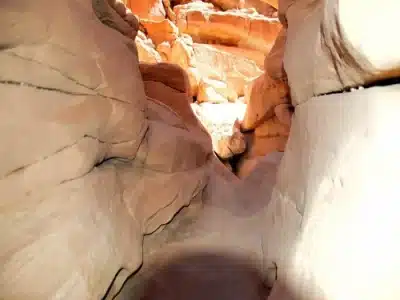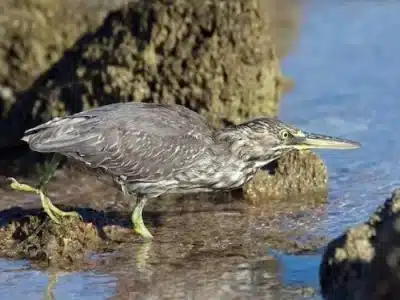from 0 review
Daily Tour
Unlimited
All Languages

Between sea and sand, where coral reefs flirt with arid plains, lies a hidden Eden—Nabq National Park Sharm El Sheikh. Tucked into the northern end of the city’s coastline, this protected area stretches over 600 square kilometers and showcases some of Egypt’s most unique coastal ecosystems. Unlike anywhere else on the Sinai Peninsula, Nabq harmoniously blends mangrove forests, sand dunes, and marine habitats, all wrapped in cultural richness and ecological significance.
It’s a sanctuary for the soul—peaceful yet alive, ancient yet ever-changing.
Where is Nabq National Park Located?
Nabq National Park lies just 35 kilometers north of Sharm El Sheikh, between the bustling resort city and Dahab. Flanked by the Gulf of Aqaba to the east and desert mountains to the west, its location makes it an easily accessible day trip while still feeling blissfully remote.
Visitors can reach the park via taxi, hired car, or as part of an organized eco-tour.
Historical Background of Nabq National Park
Established in 1992, Nabq was born from Egypt’s growing environmental consciousness. It was declared a protected area due to its diverse and fragile ecosystems—particularly its rare mangrove forests and coral reefs. Managed under the Egyptian Environmental Affairs Agency (EEAA), the park aims to balance preservation with responsible eco-tourism.
Why Visit Nabq National Park Sharm El Sheikh?
Because Nabq is where nature writes its poetry in colors and textures. Visitors come to experience:
Tranquil mangrove lagoons
Unspoiled coral reefs
Towering dunes and mountain backdrops
Indigenous Bedouin hospitality
Unmatched biodiversity of plant and animal life
It’s not just a destination—it’s a revelation.

Flora of Nabq National Park
Despite its arid climate, Nabq bursts with unexpected greenery. Key plant species include:
Avicennia marina (mangroves): Salt-tolerant trees that stabilize shorelines
Acacia trees: Providing shade and shelter in the desert
Zygophyllum and Tamarix: Hardy desert flora used in traditional medicine
These plants not only support local wildlife but also have cultural and ecological significance.
Fauna in Nabq National Park
From the desert floor to the sea floor, Nabq teems with life. Animal species include:
Gazelles and desert foxes: Swift and elusive
Geckos and monitor lizards: Adapted to extreme heat
Crabs and mollusks: Found near the mangroves
Sea turtles and dugongs: Rare marine guests
It’s a living museum of adaptation and survival.
The Unique Mangrove Ecosystem
Nabq is home to the northernmost mangroves in the Indian Ocean ecosystem. These salt-loving trees:
Purify water
Trap sediments
Provide nurseries for fish and birds
Serve as carbon sinks
Wading into these brackish waters offers both tranquility and insight into a rare, vital habitat.

Marine Life and Coral Reefs at Nabq
The underwater world of Nabq is dazzling. Coral reefs off its shores support:
Over 200 species of fish
Vivid hard and soft coral formations
Occasional reef sharks and rays
Sea cucumbers and nudibranchs
Shallow snorkel zones make it ideal for beginners and families.

Sand Dunes and Desert Landscapes
The desert within Nabq is just as dramatic. Towering dunes shift with the wind, revealing fossilized coral beds and dry river beds (wadis). This landscape is perfect for hiking, sandboarding, or simply soaking in the silence.
Bird Watching in Nabq National Park
Birders, rejoice! Nabq is on the migratory route for many species. You may spot:
Flamingos
Herons and egrets
Ospreys and falcons
Waders and songbirds
Bring your binoculars and patience—you’re in for a show.
Adventure Activities in Nabq National Park
For thrill-seekers, Nabq offers:
Quad biking through dunes
Snorkeling the reef-lined shore
Mountain hikes with panoramic views
Kayaking through mangrove creeks
Adventure meets eco-conscious exploration here.
Eco-Tourism and Sustainability
Many local operators emphasize “leave no trace” principles. Tours often include:
Environmental education
Zero single-use plastics
Support for local Bedouin communities
Nabq is an example of how tourism can protect, not deplete, the planet.
Traditional Bedouin Culture in Nabq
Several tours stop at Bedouin camps where you’ll enjoy:
Freshly brewed herbal tea
Traditional music
Handmade crafts like woven bracelets and rugs
Stories from a desert-dwelling way of life
Their hospitality is as warm as the desert sun.

Camping and Stargazing in Nabq
Nighttime in Nabq is an experience in itself. With zero light pollution, the sky explodes with stars. Organized camping tours include:
Tents or sleeping under the stars
Campfire meals
Desert storytelling
Stargazing with telescopes or the naked eye
Educational and Research Opportunities
Nabq is a field classroom. Universities, NGOs, and schools regularly host:
Ecology workshops
Wildlife tracking programs
Reef monitoring activities
Volunteer conservation projects
Students leave not only smarter, but more inspired.

Nabq National Park for Families
It’s not all hardcore adventure—families with children will find:
Shallow snorkeling areas
Easy walking trails
Educational activities
Wildlife spotting fun
Guides tailor the experience to kids’ curiosity levels.
Best Time to Visit Nabq National Park Sharm El Sheikh
Plan your visit between October and April for:
Cooler temperatures
Clear skies for stargazing
Migratory bird season
Summer visits are possible but require extra sun precautions.
Park Regulations and Visitor Guidelines
To protect the fragile ecosystems:
Stay on marked paths
Do not remove shells or plants
Avoid feeding or chasing wildlife
Bring reusable water bottles
Permits may be required for groups or overnight stays.
What to Pack for a Nabq Trip
Essential items include:
Reef-safe sunscreen
Hats and breathable clothing
Binoculars and camera
Snacks and at least 2 liters of water
Swimwear and water shoes
Opt for eco-friendly products wherever possible.
Photography and Scenic Spots
Don’t forget your camera! Top shots include:
Mangroves at low tide
Sunset over the dunes
Bird silhouettes against the sky
Colorful reef fish underwater
Golden hour brings magical hues to every frame.
Health and Safety in the Park
While safe overall, it’s important to:
Stay hydrated
Watch for sharp corals and jellyfish
Use insect repellent
Carry a basic first-aid kit
Inform someone of your travel plans if going off-grid
How to Reach Nabq National Park from Sharm El Sheikh
Options include:
Taxi: Around 30–40 minutes drive
Guided Tour Pickup: Most convenient
Self-Drive: Rent a car or 4×4 (note road conditions)
Entrance fees vary depending on activities and tour inclusions.
Tour Packages and Guided Visits
Available packages include:
Half-Day Eco Tours: Focused on mangroves and reefs
Full-Day Adventures: Combine hiking, snorkeling, and culture
Overnight Camping: Stargazing and Bedouin experiences
Prices range from $25 to $80 depending on duration and inclusions.
Real Visitor Reviews and Testimonials
“Nabq is peaceful and powerful—our kids still talk about seeing flamingos!” – Carla, UK
“The snorkeling was amazing and untouched. I loved how eco-conscious the guide was.” – Omar, Canada
“Camping under the stars with Bedouins made me feel like I time-traveled.” – Jens, Germany
FAQs About Nabq National Park Sharm El Sheikh
Is Nabq suitable for children?
Yes, with safe trails and gentle snorkeling zones.
Do I need a guide to explore?
Highly recommended, both for safety and insight.
Can I visit year-round?
Yes, but cooler months are more comfortable.
Are there bathrooms and food stalls?
Minimal facilities—bring your own food and water.
Is photography allowed?
Absolutely, but drones may require permits.
Are pets allowed?
No, to protect wildlife and habitats.
Conclusion
In a world of concrete jungles and crowded beaches, Nabq National Park Sharm El Sheikh offers something rare—peace, purity, and purpose. Here, the desert speaks in silence, the sea whispers secrets, and every mangrove root tells a story. Whether you come for the adventure, the ecology, or the sheer beauty, Nabq will leave its mark on your memory and your heart.
Leave a review